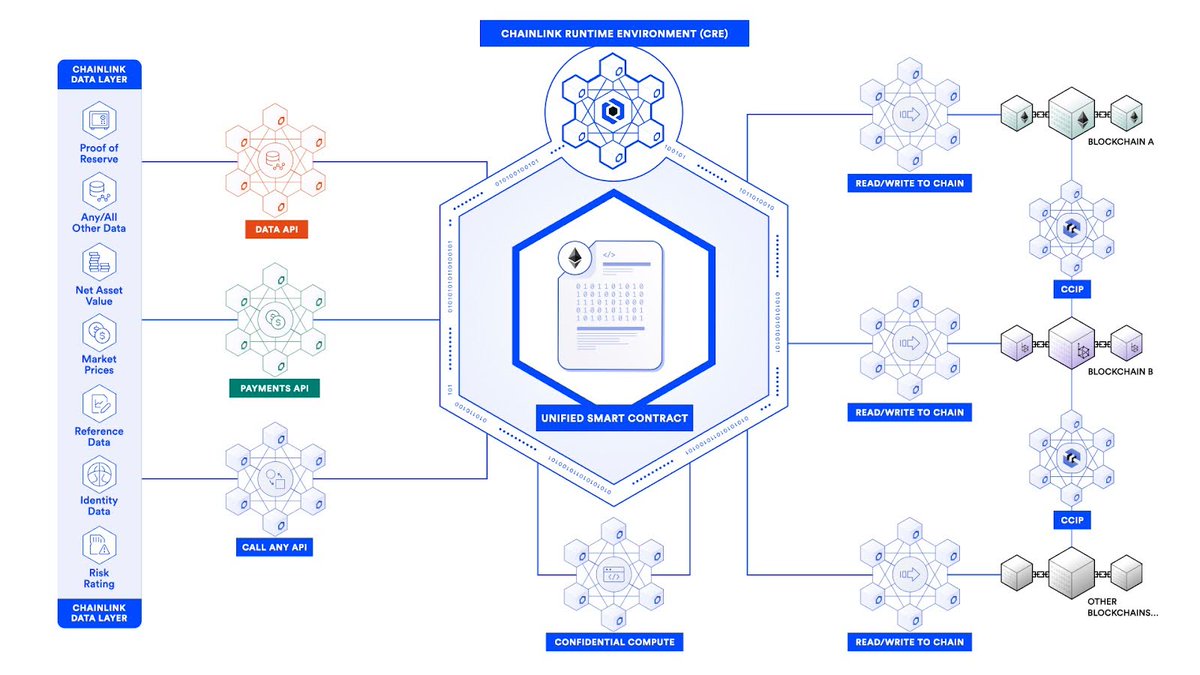People still have zero grasp of what's coming. The entire paradigm of how developers build and deploy apps is about to be inverted:
Current way: Choose chain first -> Build on-chain app next -> choose bridge/oracle at end
New way: Choose Chainlink platform first -> build all of your workflows inside CRE -> Deploy your chain-agnostic workflows onto every single chain you want to be on.
“Build Once, Run Everywhere”
The entire dichotomy of which chain will “win” is obsolete; trivial to deploy your workflows across all of them.
The thesis of Chainlink is completely different today than its early years.
How it started: A single data oracle service
How it's going: The Web3 cloud powering entire apps
Chainlink started out simple, providing existing data on to blockchains. Onchain apps used that data to make decisions like whether to liquidate a loan or how to settle a perp.
Chainlink then expanded into different types of computation (e.g., random number generation, keeper automation) before launching its cross-chain protocol. However, those were only building blocks to a much, much bigger value proposition emerging.
With the introduction of the Chainlink Runtime Environment (CRE), Chainlink is primed to be the main way developers and institutions both build onchain apps and power them through their lifecycle.
Chainlink is no longer just a service or even set of services, but the foundation underpinning onchain apps and use cases. It’s akin to the cloud but decentralized and for onchain apps, providing them the development framework for building apps, the key services they require, and the computation that powers them on the backend.
But why is this important? And why is Chainlink doing this?
The blockchain landscape is changing. You used to use a single blockchain as your cloud-like environment. But now there are hundreds of chains and you want to be able to interact across them all. Transactions are also more complex with the introduction of tokenized real-world assets (RWAs). This is the phenomenon of all the world’s existing value becoming tokenized, which is 100x the value that currently exists onchain. Thus, you must adopt RWAs if you want to succeed in this industry long term at any scale.
However, the introduction of RWAs requires new services. They require data like DeFi, but even more types of data, such as proof of reserves, net asset value, and much more. They also require compliance policies built into the asset itself and the services transacting them, which naturally needs identity data to work. Furthermore, they need privacy features, connectivity across chains, and integrations with legacy systems.
The best way to build an app like this is through a single platform that is chain-agnostic and has all the key services already built-in. This is Chainlink.
Chainlink is the only all in one platform where institutions can solve all their data, cross-chain, compliance/identity, privacy, and legacy system integration requirements. And importantly, they can combine these service into one sequential workflow (i.e., one piece of code) that Chainlink runs securely end-to-end in a decentralized manner.
This workflow is essentially an app that interacts seamlessly across chains and legacy systems while leveraging key services along its lifecycle. Once you build this workflow, you can easily reuse it and modify it to support new customers, new chains, new legacy systems, new oracle data, new use cases, etc without rewriting it all. It’s by far the most efficient and future-proof way to not only build DeFi apps, but apps for tokenized RWAs, which are the future of our industry.
This value prop puts Chainlink at the heart of onchain applications; far beyond just being a side service. The market doesn’t quite understand yet how well Chainlink is positioned, but it will because its product offering, vision, and historical track record of delivering solutions meshes perfectly with where the industry is heading and what TradFi & DeFi require to succeed in this new RWA paradigm.

20.29K
284
The content on this page is provided by third parties. Unless otherwise stated, OKX is not the author of the cited article(s) and does not claim any copyright in the materials. The content is provided for informational purposes only and does not represent the views of OKX. It is not intended to be an endorsement of any kind and should not be considered investment advice or a solicitation to buy or sell digital assets. To the extent generative AI is utilized to provide summaries or other information, such AI generated content may be inaccurate or inconsistent. Please read the linked article for more details and information. OKX is not responsible for content hosted on third party sites. Digital asset holdings, including stablecoins and NFTs, involve a high degree of risk and can fluctuate greatly. You should carefully consider whether trading or holding digital assets is suitable for you in light of your financial condition.


